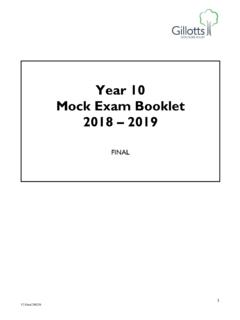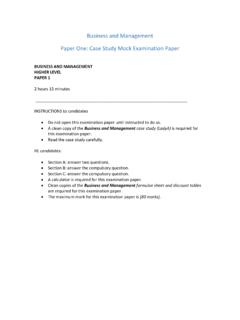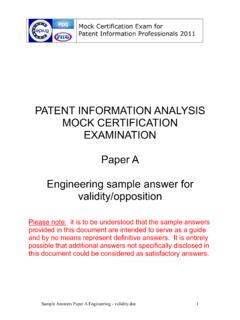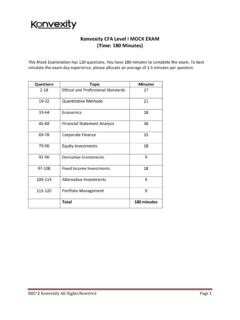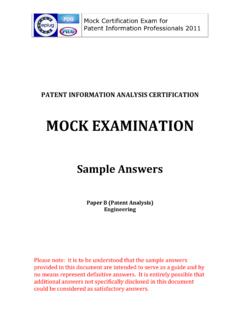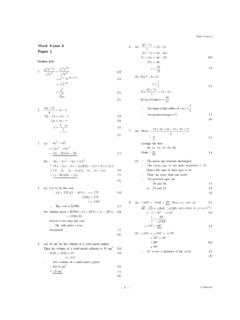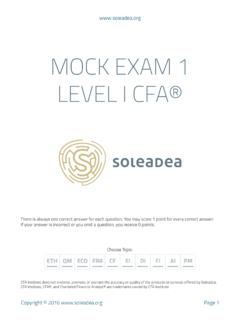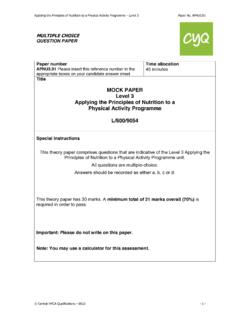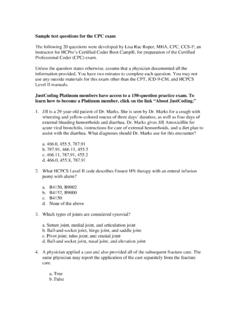Transcription of English Language Paper 2 Booklet 2: Practice Papers
1 1 English Language Paper 2 Booklet 2: Practice Papers Use this Booklet to help you revise for your mock exams in December. Name: Class: 2 Contents of Extracts Poverty 1. A description of the Irish Potato Famine by a traveller - 1847 2. A newspaper article on the plight of farmers - 2011 Sport and Entertainment 1. An extract from a book about learning to cycle - 1895 2. A newspaper article describing a visit to a Theme Park - 2012 Crime and Punishment 1. An extract describing the new prison at Pentonville - 1842 2. A website article on the overhaul of prisons - 2016 3 1. mock Paper : Poverty Source A In this extract James Mahoney describes what he saw when he travelled around Southern Ireland during the Irish Potato Famine of 1847.
2 I started from Cork, by the mail, for Skibbereen and saw little until we came to Clonakilty, where the coach stopped for breakfast; and here, for the first time, the horrors of the poverty became visible, in the vast number of famished poor, who flocked around the coach to beg alms: amongst them was a woman carrying in her arms the corpse of a fine child, and making the most distressing appeal to the passengers for aid to enable her to purchase a coffin and bury her dear little baby. This horrible spectacle induced me to make some inquiry about her, when I learned from the people of the hotel that each day brings dozens of such applicants into the town. After leaving Clonakilty, each step that we took westward brought fresh evidence of the truth of the reports of the misery, as we either met a funeral or a coffin at every hundred yards, until we approached the country of the Shepperton Lakes.
3 Here, the distress became more striking, from the decrease of numbers at the funerals, none having more than eight or ten attendants, and many only two or three. We next reached We first proceeded to there I saw the dying, the living, and the dead, lying indiscriminately upon the same floor, without anything between them and the cold earth, save a few miserable rags upon them. To point to any particular house as a proof of this would be a waste of time, as all were in the same state; and, not a single house out of 500 could boast of being free from death and fever, though several could be pointed out with the dead lying close to the living for the space of three or four, even six days, without any effort being made to remove the bodies to a last resting place.
4 After leaving this abode of death, we proceeded to High-street, or Old Chapel-lane and there found one house, without door or window, filled with destitute people lying on the bare floor; and one, fine, tall, stout country lad, who had entered some hours previously to find shelter from the piercing cold, lay here dead amongst others likely soon to follow him. The appeals to the feelings and professional skill of my kind attendants here became truly heart-rending; and so distressed Dr. Donovan, that he begged me not to go into the house, and to avoid coming into contact with the people surrounding the A specimen of the in-door horrors of Scull may be seen in the annexed sketch of the hut of a poor man named Mullins, who lay dying in a corner upon a heap of straw, supplied by the Relief Committee, whilst his three wretched children crouched over a few embers of turf, as if to raise the last remaining spark of life.
5 This poor man, it 4 appears, had buried his wife some five days previously, and was, in all probability, on the eve of joining her, when he was found out by the untiring efforts of the Vicar, who, for a few short days, saved him from that which no kindness could ultimately avert. Our Artist assures us that the dimensions of the hut do not exceed ten feet square; adding that, to make the sketch, he was compelled to stand up to his ankles in the dirt and filth upon the floor. Source B This extract looks at the plight of farmers in a newspaper article of 2011 We must not ignore the plight of our farmers - Rowena Davies reports on one farmer s struggle to cope. Dave is not his real name. He s too scared to tell me that in case his family farm becomes a target for animal rights activists, just because he agrees with the government s plan to cull badgers as a way of stopping the spread of tuberculosis (TB), a serious disease, in cattle.
6 He s been a farmer in Devon for over fifty years. His family works an exhausting fourteen hours a day, seven days a week, to look after their dairy herd of 1,000 cows, nursing them through birth and hand feeding them when they re sick. When Dave started farming fifty years ago, he used to shoot badgers, and none of his cows suffered from TB. When badgers became a protected species he stopped shooting them. Now there are badgers on his land and regular cases of TB in his herd. This picture has been repeated at a national level. TB is now devastating herds of cattle across the countryside. In 1998, fewer than 6,000 cows were killed because they had TB. In 2011, the figure rose to 34,000. To deal with the huge number of cattle being infected with TB, the government is planning to allow farmers to shoot badgers.
7 It believes that badgers are responsible for spreading this devastating infection that is killing cattle and driving farmers out of business. Science is very much on the side of culling badgers, because TB was under control in the 1970s and 1980s and has only become a problem since 1992 when it was made illegal to kill badgers. Since then the badger population has grown considerably and TB in cows has increased dramatically. Farmers don t want to kill all badgers, just those that have TB, says Dave. It s only when their numbers get out of control that they start causing infections. Because they have no natural predators, it s up to us to keep the numbers down or they take over. 5 Working so closely with infected animals meant that Dave s son-in-law came down with TB himself.
8 His family stood by as he lay in bed rapidly losing weight and coughing, but they still want to keep going. My family want to carry on farming, says Dave, They love it and their children love it. It s in our blood. Animal rights groups and charities say that the answer is vaccines. But there is no suitable vaccine for cows. The National Farmers Union says vaccinating badgers is incredibly difficult because to be effective each badger has to be caught in a cage and needs to be vaccinated once every year for four years. This makes it a very expensive operation. It s difficult to explain how difficult life in the countryside already is. Back in Devon, one of Dave s neighbours has recently gone out of business.
9 The price of milk paid to farmers has been slashed by 4p a litre this year, and supermarkets now sell milk at barely the cost of production. It s been too wet to graze the cows outside, so feed supplies have been used up and the increased price of grain is hitting farmers hard. Britain has lost 40 per cent of its dairy farms over the last ten years and TB is increasing that percentage every year. Something has to be done. Exam style questions: Question 1: Read paragraphs 1 3. Shade the four statements below that are true: A. The writer is from Cork. B. He stopped for breakfast in Clonakilty C. A lady is begging for money for a coffin for her dead child D. More than 20 people attended all the funerals the writer saw E.
10 The writer stopped at Shepperton Lakes F. The writer went to Skibbereen after Bridgetown G. The writer was attending a funeral in Skibbereen H. The writer ate porridge for breakfast. Question 2. Use details from both sources. Write a summary of the similarities of those people who are suffering in these two extracts. (8 marks) Question 3 Refer only to Source B, the newspaper article on the plight of farmers. 6 How does the writer use Language in this article to present her views on the plight of farmers? (12 marks) Question 4 For this question you should refer to both Source A and Source B. Compare how the two writers convey their views on the suffering of those described in these two extracts. (16 marks) In your answer you should: compare their views about the suffering of those they are describing compare the methods the writers use to convey their views Support your ideas from quotations from both texts.

